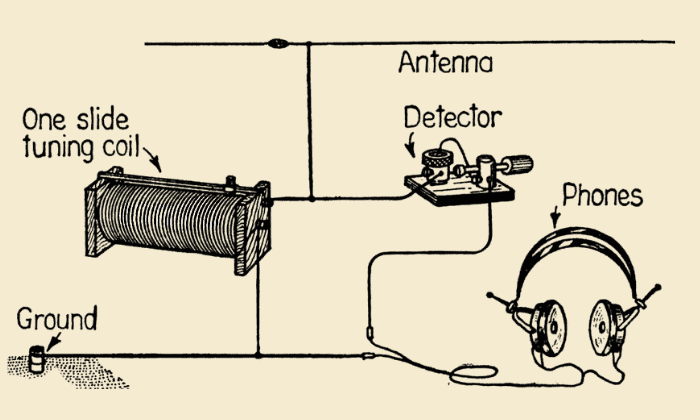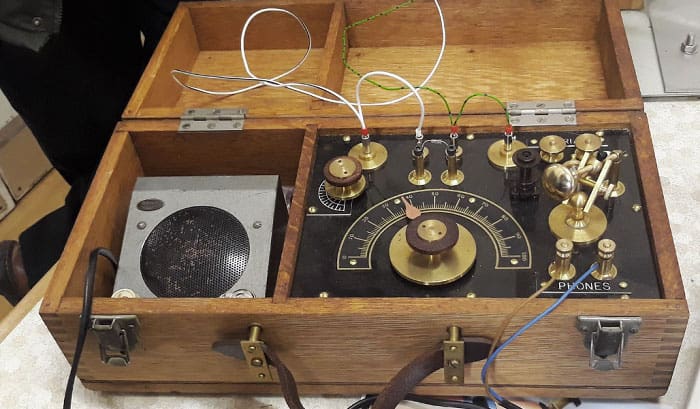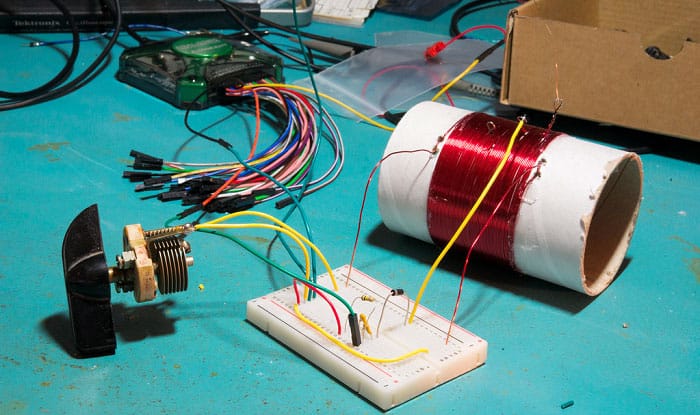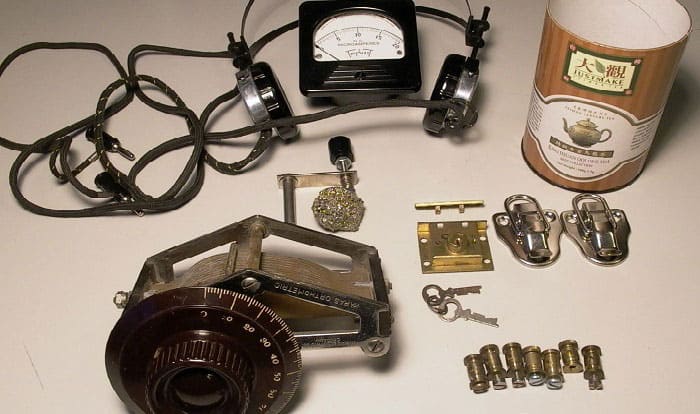Crystal radios receive radio signals from the antenna to the earphones attached to the radio.
This is achieved through an antenna-ground system receiving radio waves, a tuner selecting which radio frequency to detect, a detector turning these into impulses, and a reproducer translating them into sound.
This may sound unfamiliar because it’s obsolete. But, it has certainly been part of the original teens’ lives because of its popularity during the 20th century.
So, how does a crystal radio work?
Contents
Overview of a Crystal Radio
But before we tackle that, let’s start with the history of crystal radios.
Crystal radio manufacturer PV Scientific Instruments say that crystal radios go way back to the turn of the 20th century when American scientist Greenleaf Whittier Pickard discovered that several natural-occurring crystals can detect radio waves.
Back then, old crystal radios could be made from a five-cent mineral called galena and safety pins– the galena crystal radio. This DIY crystal radio receiver served as entertainment for kids and adults alike during the Great Depression.
Components of a Crystal Radio
A crystal radio only has four components. These crystal radio parts are easily sourced, and the operation is quite easy.
1. Antenna
The antenna connects the radio from the ground to the air to receive radio waves. The ideal crystal radio antenna is made from 18-36m long enameled copper wire or a 6-9m insulated copper wire.
2. Tuner
The radio’s tuner is responsible for detecting which radio frequencies will be detected. Hobbyists can use a metallic water pipe in tuning crystal stations.
3. Diode
The crystal radio diode uses a germanium diode with less than 300mV. This crystal is responsible for turning the energy into electric impulses.
4. Reproducer
The crystal radio reproducer produces the sound you’ll hear on a crystal set radio. A high-impedance headphone is commonly used. You can also use the old headphones of a dial-type landline receiver.
How Does a Crystal Radio Work?
Crystal radios transform radio waves into sound through a crystal radio circuit. Here’s a step-by-step guide and a schematic diagram of how crystal radios work:
Step 1: The antenna-ground system collects radio waves through the wires.
The antenna-ground system is a piece of wire where one end is connected to the ground while the other end is up in the air.
This phenomenon creates an electric current of radio waves that flow through the wire.
Step 2: The coiled tuner selects a radio frequency to detect.
The tuner blocks other radio waves to detect only one broadcasting station. These can be controlled with a variable condenser to choose which radio frequency to detect.
Step 3: Crystal diodes turn the energy into electric impulses.
Once the broadcasting station has been selected, the crystal diode can transform these into electric impulses. These impulses are needed to operate a reproducer.
Step 4: The reproducer transforms these impulses into sound waves.
The electric impulses from the diode are then turned into sound waves. The reproducer or headphones work as an electromagnet that causes the diaphragm to vibrate and turn these into sound waves.
Pros and Cons of a Crystal Radio
There’s a reason why crystal radios became popular. This is because of its numerous advantages that helped shape today’s radios. However, technology is a never-ending development; thus, more innovations have come to replace the crystal radio.
Here are some of the pros and cons of crystal radios.
Advantages of the crystal radio
- Can be used without batteries
- Simple to use
- Easy to build
Disadvantages of the crystal radio
- Low sensitivity
- Can only detect am broadcasting stations
Applications of Crystal Radios
Now, what does a crystal radio do? and where is it used?
For your information, it’s a news and entertainment tool used to pick up and listen to am (amplitude modulation) radio stations, although there are also FM crystal radios built.
Differences Between Crystal Radio And Regular Radio
Crystal radios and regular radios both broadcast the sounds from a network. But crystal radios do not need electricity or batteries. However, since they only rely on radio waves, the crystal radio kit can only detect nearby frequencies.
According to studies from The University of Utah, the sound is clear, but the signal could be weak. On the other hand, regular radio requires electricity or batteries and is more high-tech than crystal radios.
Tips for Building Your Crystal Radio
Making crystal radios is a good science experiment for kids. Here are some tips on how to make a crystal radio for your or your child’s next project.
- Use a straight, long antenna
- Check on your ground
- Make sure all wires are connected well
- Work on germanium diodes only
- Use crystal earpieces
- Test it out with an amplifier
Frequently Asked Questions
Does a crystal radio need a battery?
No, crystal radios don’t need batteries, nor do they need to be plugged in—crystal radios work by receiving radio signals from their antenna-ground system. However, remember it won’t be as strong as a regular radio.
What frequency is crystal radio?
Crystal radios can detect the frequencies of an am radio station. These frequencies range from 540 to 1610 kHz. Also, remember that distance and power play a role in detecting a radio station.
How far can a crystal radio receive radio transmissions?
How far your crystal radio can receive radio transmissions varies depending on your distance from the broadcasting station and the signal power of the broadcasting station. Ultimately, you won’t be able to hear clearly with an indoor antenna unless you live only miles away from the station.
Conclusion
The invention of the crystal radio has deeply impacted the lives of a lot of people. It’s one of the first radios ever produced, and it still fascinates many up until today.
This is because crystal radios are easy to build and operate. Crystal radios also need not be plugged in and placed with batteries. People, especially during the Great Depression, utilized this tool because it was inexpensive.
Today, people have still been curious about what is a crystal radio and how it works. This invention has also become a famous science project that many kids, students, and even adults love!

Hello! I am Hart, the content writer and editor here at G0HWC. I used to be in the same local radio club with Howe, and he convinced me to join him in spreading my love for the radio with others. With a background in radio studies, I spend every day crafting accurate, easy to read content on various topics related to owning and using radios. I hope that my content can help you confidently venture in your radio journey!







